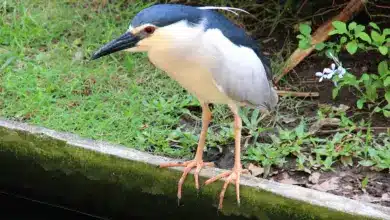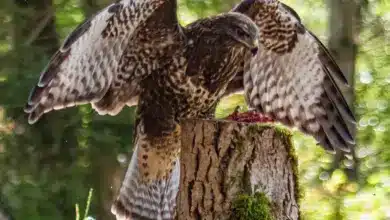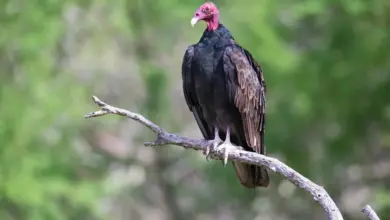Egyptian Vulture (Neophron percnopterus)
The Egyptian Vulture (Neophron percnopterus) is a small Old World vulture, found from southwestern Europe and northern Africa to southern Asia.
It is the only living member of the genus Neophron. In Southern Asia, this species is called the Scavenger Vulture.
Taxonomy
There are three recognized subspecies of the Egyptian Vulture:
- N. p. percnopterus, the nominate subspecies, has the largest range, occurring in southern Europe, northern Africa, the Middle East, Central Asia, and the north-west of the Indian subcontinent
- N. p. ginginianus, the smallest subspecies, occurs in most of the Indian subcontinent
- N. p. majorensis, the Canarian Egyptian Vulture, the largest subspecies with by far the smallest and most restricted population, is found only in the eastern Canary Islands
Description
The adult Egyptian Vulture usually measures 85 cm from the point of the beak to the extremity of the tail feathers and 1.7 meters between the tips of the wings. It weighs about 2.1 kilograms.
The adult plumage is white, with some black feathers in the wings and tail. Due to its habits—stalking around carcasses on usually dusty ground to wait for its turn—the plumage dulls quickly, and birds before moult are beige rather than pure white.
Also, individuals occasionally seem to “paint” themselves with soil containing iron oxide, as Lammergeiers do, turning their plumage a pinkish buff; hence the German name Schmutzgeier (“dirt-vulture”).
Its facial skin is yellow, turning orange during nesting periods, and is devoid of feathers. The tail is diamond-shaped, so it is easily distinguished in flight.
The nestlings are dark brown and gradually become light until they reach adulthood at the age of five.
Distribution
Egyptian Vulture are quite widely distributed and may be found in southern Europe, northern Africa, and western and southern Asia.
They are partial migrants, depending on the local climate. If an Egyptian Vulture can endure the winter, it usually will not migrate. The species is not well adapted to cold weather due to its rather small size (see Bergmann’s Rule).
Use of tools
The Egyptian Vulture is one of the species that are known to use tools. It uses small rocks (please refer to below photo) to crack thick-shelled ostrich eggs by lifting a stone with its beak and hitting the egg in a strong swing of head and neck.
Presumably, this is culturally learned, by observing others in the social group. This is very effective in survival for the Egyptian vulture.
Diet / Feeding
Egyptian Vulture are scavengers, mainly feeding off carrion, but they also prey on small mammals and eggs.
Due to its relatively small size, it needs to wait until other scavengers (such as the larger Gyps vultures, hyenas, and lions) finish their meal before it may start feeding. Its head and beak are well-fitted for this situation.
As with other vultures, it is believed that the bare skin prevents food from sticking to it.
Using its long beak, an Egyptian Vulture can tear off small pieces of meat left by larger scavengers. The thin beak also can fit through narrow spaces between bones to get food that large-beaked vultures cannot reach.
Breeding
The Egyptian Vulture reaches sexual maturity at the age of five and breeds in the same manner as most other birds of prey. They mate for life.
The nests are built in areas of cliffs and slopes on inaccessible ledges or niches in rocky walls. Both the male and the female take part in the nest construction. They use branches for the frame and upholster it with garbage and food remains (skeletons of small mammals, turtle shells, etc.). They
carry the nesting materials in their beaks, unlike most other raptors, who use their talons instead. The nest is reupholstered continually during the nesting and brooding period. The female lays two white eggs with dark brown spots (94 grams, 65×55 millimeters) with a few days’ intervals between them. This usually occurs between the end of March and the end of April.
Conservation status
The Egyptian Vulture is declining in large parts of its range, often severely. In Europe and most of the Middle East, it is half as plentiful as it was about twenty years ago, and the populations in India and southwestern Africa have collapsed entirely. In the case of India, this is attributable to the widespread use of the NSAID Diclofenac in veterinary medicine, which enters the food chain of the species; the drug is extremely poisonous to vultures. Consequently, this species was uplisted from Least Concern to Endangered status in the 2007 IUCN Red List.
Cultural significance
In Ancient Egypt, the vulture hieroglyph was the uniliteral sign used for the glottal sound including words such as mother, prosperous, grandmother, and ruler.
In Egypt, it is called the Pharaoh’s Chicken for two reasons. It looks somewhat like a scruffy white chicken in fresh plumage, and the relationship to the pharaoh is because this bird was the symbol of perhaps the oldest deity of southern Ancient Egypt, Nekhbet, who was considered the protector of the pharaoh, royalty, and Egypt and always shown with her extended wings.
They referred to the bird as the Mother of Mothers, who has existed from the Beginning and creator of the world. This vulture always was seen on the front of the pharaoh’s crown.
After the unification of Egypt, both she and Wadjet (another early goddess in the Egyptian pantheon who had the same role in northern or Lower Egypt) shared the location of the protecting deity on the new double crown that was worn by the pharaohs of every dynasty thereafter.
The nurturing behavior of these vultures while rearing their young led to a view of them as model parents, and their lack of sexual dimorphism led the Ancient Egyptians to think, mistakenly, that they were all female and reproduced through parthenogenesis.




